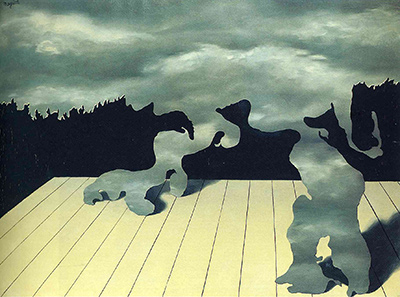The surrealist painter René François Ghislain Magritte was born in Lessines, Belgian in 21 November 1898. Throughout his artistic career, he created many thought-provoking and witty paintings that challenged the observer’s perception by putting normal images in unusual places and settings.
He died on 15 August 1967 at the age of 68. The pop, conceptual and minimalist art scenes were influenced by his inspirational use of imagery. His most popular surrealist paintings include The Treachery of Images, The Human Condition, The Menaced Assassin, Elective Affinities, On the Threshold of Liberty and The Son of Man.
The Muscles of the Sky was one of the first paintings Magritte created after his move to Paris in 1927. He moved to Paris after abuse from critics over his Brussels exhibition in the same year believing that his ideas would be better met in another country. Once in Paris, he became a leading member of the surrealist group after meeting Andre Breton. He stayed in Paris for the next three years of his life.
The Muscles of the Sky combines the Albertian pavement with the sky as a pictorial element. The sky breaks from the top of the image over the dark middle onto the foreground. The spatial instability overrides the function of the pavement, which is to accommodate objects. There are no solid objects in the painting as they have no place.
Magritte wanted to make the ‘legs of the sky’, as he put it, the focus of the painting. The pavement has the characteristic of wood due to their clear lines, faint shadows and colour. The wood symbolizes a rigid plane, which is contrasted by the sky’s characteristics.
The Muscles of the Sky was to be one of the first in a long line of surrealist paintings. The impact Magritte made in Paris was minimal and as such, he returned to Brussels in 1930. Once there, he joined with his brother Paul to form an advertising agency to earn a living wage.




